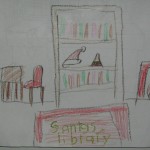Yesterday was an art week for the preschool storytime, and for our project I chose “Circle Weave” from MaryAnn Kohl’s book Preschool Art, my favorite resource for great art ideas for ages four to seven.
Before the project, though, I read three books to the kids. I realize I’ve been remiss lately and haven’t been reporting on what books have been a hit in storytime, so here is a brief rundown on the books I used yesterday and the reactions of the kids to each book:
First up was Scaredy Squirrel at Night by Melanie Watt. I broke the cardinal rule of storytimes, and didn’t preview this book before I read it aloud. Big mistake. Though cute, this book doesn’t lend itself well to a storytime read aloud (which I should have remembered from reading the first two Scaredy Squirrel books to storytimes in the past). Too many little details in little pictures – the kids had a tough time seeing what was going on in the pictures and also understanding the story line. I’d still recommend this book, but for a lap sit reading with one or two children; in a lap sit, kids would be able to really study the pictures and also ask questions about what is happening in the story.
The kids were an exceptionally patient, sweet group, though, and lasted well through the first story, even though they weren’t totally engaged. Next up: Rhyming Dust Bunnies by Jan Thomas. I love Thomas’s illustrations, and I love the all-out goofiness of the storyline: four dust bunnies finding rhyming words – all except Bob, who keeps saying things that don’t rhyme, like “Look out!” Bob, of course, is the voice of reason, trying to warn his fellow dust bunnies that there is a broom and a vacuum cleaner after them. I thought the kids would find this situation funny, but in fact several were deeply disturbed (and I do mean deeply disturbed) that the dust bunnies were being harmed. I tried to explain that dust bunnies are just bunches of fluffy dirt that we all clean up, but my explanation was met with furrowed, worried brows.
After that flop, I was ready to move right on to the art project, but H. pointed out that I still had one book left to read. So we read Potato Joe by Keith Baker, a book that I had put in my preschool storytime pile a couple of weeks ago. I don’t know what I was thinking. The book is just too young for this crowd, and though they were patient with it, and counted the potatoes aloud with me, they were clearly bored by it. I’m not condemning this book, though; it would be an excellent choice for my toddler storytime, and I will definitely use it for that group in the future.
On to “Circle Weave.” For this project, I pre-cut a couple of dozen five inch diameter circles from poster board of various colors. I also pre-cut two foot lengths of yarn; I had bought yarn in five different colors, two of which are cool multi-color skeins of varying shades. Before embarking on the project, I introduced it to the kids by showing them the pile of poster board circles. Then I showed them a circle with six small triangular slits cut around the edge (see Kohl’s book for an illustration and details on how to do this). We talked about how the circle with the slits was different from the other circles, and I told the kids that their first assignment was to cut their own slits.
This proved to be way too much of a challenge for the kids. I had incorrectly assumed that parents would come in to the room to help out with the slit cutting, but many of the adults had very young children they needed to watch and thus were unable to assist. Luckily, none of the kids had a meltdown when they struggled with cutting, and luckily, I was able to quickly cut slits in stacks of circles. But there were ten dicey minutes at the start of this project where I thought for sure it would be an absolute failure. All of the kids were frustrated with the cutting, some of the kids were having a really tough time with taping the ends of yarn to the back of their circle (one boy pulled off two feet of scotch tape and looked up at me with puzzled, desperate eyes), and one little boy totally didn’t understand that we only need to use one piece of yarn at a time.
But suddenly the tide turned, and everyone started to have fun. Some kids did straight weaving, lacing the yarn in and out of the slits, but other kids got incredibly creative. We had necklaces, earrings, bracelets, and paper dogs being walked on yarn leashes. We had letters woven on to the circles. Each child kept asking for another circle, please, and each child made at least five woven circles. One little boy kept leaving the room – I thought he was bored and leaving, but he was actually delivering woven circles to his mother, then he’d come back to make another. The kids kept at this project for a full half hour, and only stopped when their parents came in to say it was time to go.
This art project was a very good lesson for me as a teacher/facilitator: don’t give up if you think the project isn’t working. Have patience, let it evolve, let the children be challenged for a bit, and allow them to come up with their own solutions to the difficult task given to them. If you give the kids the space and freedom to work, they will end up surprising you with their creativity and artistic joy. And then everyone leaves happy: teacher, children, and parents.

